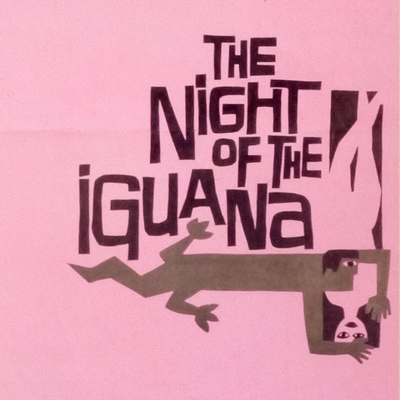It's hard to prove, but there are films where one scene is the salient visual moment that everything before and after seems to flow through, in all likelihood the gem of inspiration that the director spent months or years and millions of dollars to capture. I'm certain that directors like Stanley Kubrick, Francis Ford Coppola or Terrence Malick have bet their careers on films built around a single scene. And I'm just as sure that the putative failure of films like Malick's Days of Heaven or Coppola's Dracula are because the directors couldn't come up with enough adjacent movie to justify their single inspirational scene (or scenes).
It's flexible as theories go; you can apply it to almost any other artistic form – a novel that hangs from a single paragraph, a poem constructed around one line, a song around a snatch of melody, a chorus or a chord change. Some artists made this such a specialty that their best work is famous for these fleeting moments – high points of poetry and inspiration that survive independently as quotes, artifacts of verbal or visual shorthand that sum up everything the layman needs to know about them.
American theatre, in its last golden period after World War Two with playwrights like Tennessee Williams, Arthur Miller and Edward Albee, seemed addicted to these moments that suddenly amplified a line from the script as if pasted across a billboard. Nobody did this better than Williams, starting from his first success with The Glass Menagerie through A Streetcar Named Desire, Cat on a Hot Tin Roof and Suddenly Last Summer.
In what was his last great play from his most successful period, The Night of the Iguana, that promontory moment comes near the end, during a long scene between the disgraced priest Shannon and the spinster artist Hannah, while she tries to talk Shannon down from the suicidal fervor of a nervous breakdown. The clergyman tries to get a rise out of her by goading the kind, lonely woman into talking about the two rare instances of sexual engagement in her life, which she calmly recounts to him, free of the shame and prudery that he'd assumed of her.
"Nothing human disgusts me, Mr. Shannon," she tells him, "unless it is unkind or violent."
This briefest of lines distills everything Williams was trying to paint for his audience, based on his idiosyncratically Christian, fervently humanist, abidingly sordid worldview. A broken man like Shannon, though provisionally rescued from sexual outcast status by success in his peculiar field, the line – the whole play, let's be frank – was a plea to find more than mere tolerance for damaged and failing members of the herd.
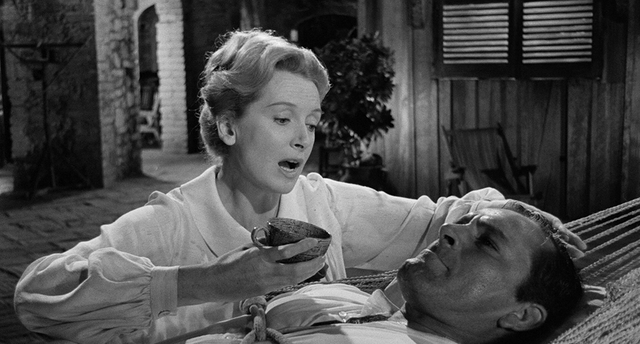
Unlike Miller and Albee, Williams had the great fortune to write theatre that consistently translated well on to the big screen, and when The Night of the Iguana opened on Broadway at the end of 1961, it was a forgone conclusion that it would find its way into cinemas shortly, joining plays like Glass Menagerie, Streetcar, The Rose Tattoo, 27 Wagons Full of Cotton (made by Elia Kazan as Baby Doll), Cat on a Hot Tin Roof, Suddenly Last Summer and Orpheus Descending (directed by Sidney Lumet as The Fugitive Kind) – as well as his novella The Roman Spring of Mrs. Stone (made into a film starring Warren Beatty) – and maintaining Williams' status on Broadway and as a celebrity, not to mention his back account.
The movie version of Iguana was intended for director Alexander Mackendrick, whose first American picture Sweet Smell of Success had flopped and was having a hard time getting a follow-up project made. (There's an alternate history many of us would like to see; you can't help but speculate at the Williams movie Mackendrick would have made instead of Sammy Going South or A High Wind in Jamaica.)
But producer Ray Stark (whose first and only film so far was The World of Suzie Wong) acquired the rights for the Williams play after the playwright had asked Gavin Lambert to write a first draft of a script. Stark intended to give the project to his friend John Huston, whose fondness for literary properties was well known.
Huston, fresh off The Misfits, Freud: The Secret Passion and The List of Adrian Messenger (a typical sequence of Huston hits, misses and curiosities), threw out Lambert's script and wrote a new one with Anthony Veiller (The Stranger, The Killers, Moulin Rouge, Beat the Devil. It would be Veiller's last film; he died of cancer a year after it was released.)
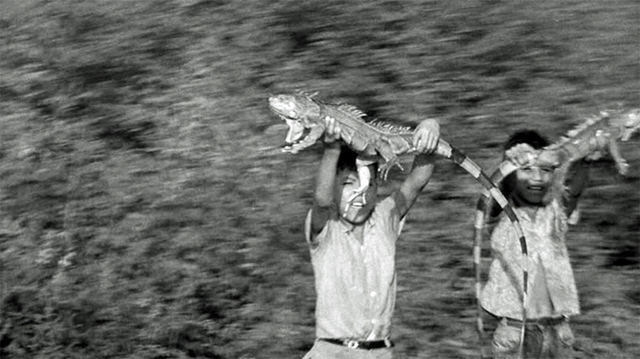
Huston also typically decided to make the film on location in Mexico. Huston liked shooting on location; according to Jeffrey Meyers in his biography of the director, John Huston: Courage and Art, the director believed that "in a remote, uncomfortable and even dangerous place, they would gain intensity and commitment, and give superior performances."
To that end he chose the backwater of Mismaloya in Jalisco on the Pacific coast, eight miles by boat from Puerto Vallarta, to host the set for the rundown cliffside hotel owned by the recently widowed Maxine Faulk. For the spinster Hannah Jelkes he cast Deborah Kerr; for Maxine, Ava Gardner; and for the desperate and dissolute Rev. Shannon he chose Richard Burton, fresh from the epic debacle that was Cleopatra and accompanied on set by no less than Elizabeth Taylor, soon to be his wife. In their wake came the inevitable throng of press and paparazzi.
For Charlotte, spoiled jailbait and the agent of chaos afflicting Shannon – now forced to work as a guide for a bottom-of-the-barrel Texas travel agency – Huston cast Sue Lyon, who had debuted two years earlier in the title role in Stanley Kubrick's Lolita and was on the verge of a career that would wane continuously until she retired from acting in 1980 after playing a newswoman in the Z-picture Alligator.
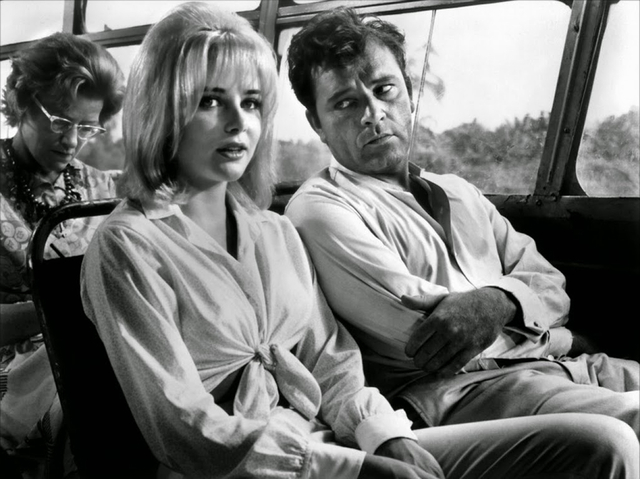
Huston being Huston, he kicked off filming by gathering Stark and his stars together and presenting each of them with a gift – a gold-plated derringer with five bullets, each one engraved with the names of the rest of the group, "as if he expected them all to kill each other by the end of the movie," as Meyers writes.
(Macabre, to be sure, but I'd love to do the same thing at our next family Christmas dinner.)
Concerned (as he should be) about opening up Williams' story from its stagebound origin, Huston begins the film not in Mexico but two years earlier, when Rev. Shannon uncertainly mounts the pulpit at his Episcopalian church in Pleasant Valley, Virginia. He stumbles with a solemn homily before turning on his congregation, accusing them of showing up to "see this city with its broken walls," to "feed their appetites" and "scalp" him for some unnamed transgression. He ends by berating them for their willingness to believe in a God that sounds like an "angry, petulant old man" and a "cruel, senile delinquent", chasing his congregation from the pews and out the doors of the church.
It would be impossible to imagine a scene like this in a movie made in 1939, or a decade or even two later. But by 1964 the old Production Code was mostly threadbare, the victim of a thousand cuts and the pointed neglect of the independent producers who had taken the place of the studios. They had seen what playwrights like Williams could say with impunity on the stage and intended to give him a platform on the screen for more of the same; it was certain to attract the wrath of editorial writers and the Catholic Legion of Decency, but that was a risk they were willing to take if a whiff of controversy might attract viewers back into theatres eager to see what they couldn't get on television.
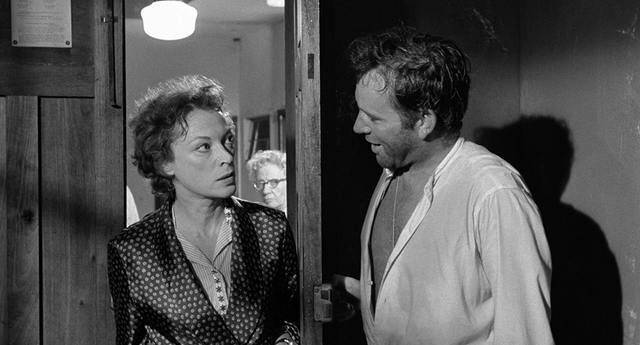
When the camera finds Shannon again he's outside another church in Mexico, a newspaper on his head to shield him from the sun, hiding an empty bottle of beer from his tour group – a delegation from a Texas Baptist women's college led by the sourly priggish Miss Fellowes (Grayson Hall) and featuring her 16-year-old niece Charlotte (Lyons), a hormonally overclocked nymphet who has conceived of a passion for the faltering Shannon. If you are to proceed with Williams' story a moment further, you have to accept that Burton's Shannon, bathed in flop sweat and smelling of drink, is as irresistible to young women as Fabian.
(What's really interesting is that Williams' version of hell is an Episcopalian minister and Baptist women in a Catholic country. It might be the most plausible thing about the story.)
Trapped between Charlotte's misplaced ardour and the disapproval of Miss Fellowes, Shannon needs to find a place to regroup in sympathetic company, so he commandeers the wheel of the tour bus and races past their hotel in town. He pulls up in front of a beachside hostelry, yanks the distributor cap out of the bus and runs up some cliffside stairs to find out that Fred Faulk, the man he was looking for, has been dead just shy of a month.
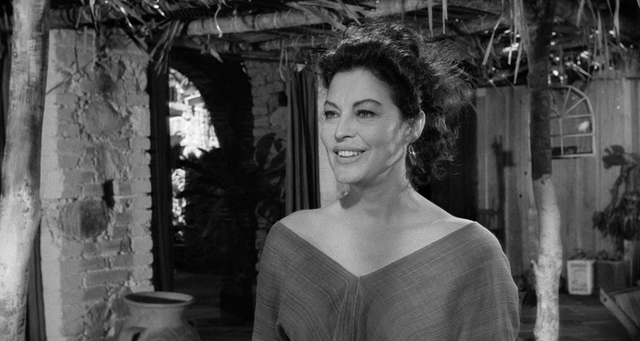
His widow Maxine informs him that the hotel is closed for the season, but he pleads with her to take in his hostile tour group and give him a chance to win them over and spare his job – at least until he can convince his bishop back in Virginia to let him don his collar again. Just as she relents the genteel Miss Jelkes climbs the stairs from the road below leading her frail grandfather Nonno (Cyril Delevanti), who she introduces as the world's oldest living poet, himself in search of a refuge next to the sea.
With his cast pinned firmly in place, Huston can set about letting them work on each other roughly as Williams had laid out in his play.
If Huston craved hardship and drama on his sets, his cast for The Night of the Iguana rewarded him by bringing more than he might have bargained for with their baggage. There was Burton and Taylor, their entourage and camp followers and media circus, of course, but as Meyers recalls in his biography of the director:
"The beautiful and talented, though sometimes drunken and miserable Ava Gardner, as well as the flirtatious seventeen-year-old Sue Lyon...were equally notorious. Michael Wilding, who'd once been Elizabeth Taylor's consort, continued to serve by handling publicity for Burton. Peter Viertel who – like his old pal Huston – had once shared Gardner's bed, had recently married Deborah Kerr and was on the scene with her."
Gardner herself recalled that "everyone was on edge from the heat and the sickness. Scorpions and iguanas hopping on your bed. You never knew if you were going to be bitten by something or stranded by a storm...Everyone got a bit desperate, everyone wanted to be loved or to love."
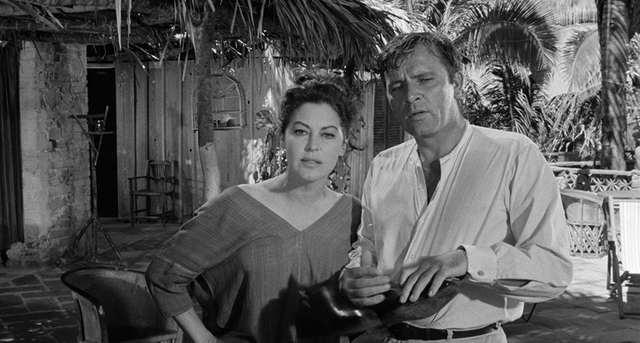
Burton, who had just played the Archbishop of Canterbury in Becket, is in a manic mode for much of the picture (as opposed to the laconic one he could retreat into with pictures like The Spy Who Came in From the Cold). He chews through a great deal of the scenery as Shannon, though to be fair Williams gives him plenty of lines meant to convey his paranoia and suicidal desperation, like when he describes statutory rape as a "a man seduced by a girl under twenty" or, finding himself trussed up in a hammock and in the care of Gardner and Kerr, speculates that "all women want to see a man in a tied-up situation."
It's easy to see how, after this picture, Lyons was never considered worth much more than variations on Lolita, which put a rapidly approaching sell-by date on her career. But Williams doesn't give her Charlotte much to do besides throw herself at Shannon and embody the hysterical romantic delusions of overstimulated young females at the head of a thronging cohort of teenagers. Though her generation still didn't have a name, they elicited the same dismay and disapproval from Williams, a gay southern writer, as you'd get from a columnist at a Boston broadsheet, an evangelical preacher from Alabama or an executive at Columbia Records.
Deborah Kerr's Hannah Jelkes was not a stretch for the actress, who had made something of a specialty of women who suffered beautifully for the camera. Her chastity and self-sacrifice should elicit approval from the minister who has lost faith in himself and humanity but not in God, but Shannon initially treats her with disbelief, baiting her relentlessly, mocking her virtue as evidence of something lacking and not evidence of grace. One presumes that it's Williams providing evidence that Shannon was never suitable for the priestly role he insists that he needs to assume again.
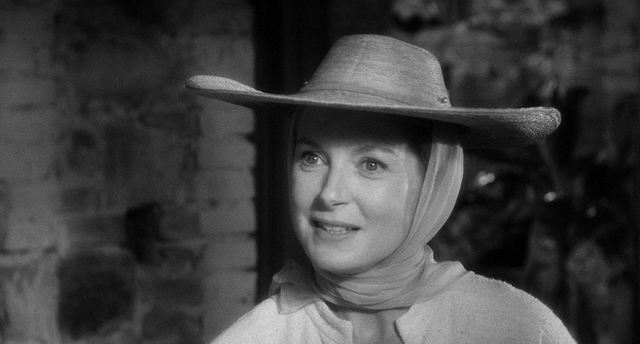
Williams wrote the role of Maxine for no less than Bette Davis, who starred in The Night of the Iguana when it opened on Broadway, but she left the play after just over three months; according to Neil Sinyard's essay on the transformation of the play into a film published in The Tennessee Williams Annual Review in 2016, Davis had been playing the role more to the audience than the actors onstage with her, and that left her unhappy with the production despite her enthusiasm for the role and with returning to the stage.
She was replaced by Shelley Winters, who discovered that the actors playing Shannon and Hannah were stepping on Maxine's jokes attempting to sabotage the character. "I never envisaged having to act while defending myself and watching two gifted actors destroy a play," she wrote later, and Sinyard notes that "the role of Maxine has consistently been the most difficult to bring off successfully, as the best notices have invariably gone to the actors playing Shannon and Hannah."
Gardner had doubts about having the talent to play Maxine, but Stark reassured her that Huston would guide her to a perform like "a streamlined Sarah Bernhardt." In the end there's no reason to worry about Gardner being upstaged by Burton and Kerr – she's fantastic in the role, which is probably among her very best, though the only performance that got an Oscar nomination was Grayson Hall's.
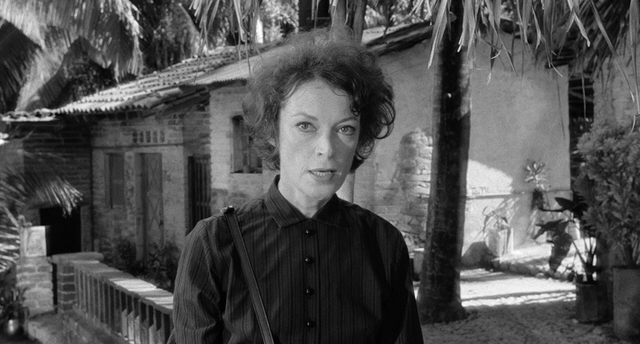
Lusty and outsized, Gardner is the only cast member who imbues her part with conviction, playing Maxine with a southern accent much like her own, and inviting speculation about how close the character came to the real Gardner. Maxine is frequently in the company of Pepe and Pedro, two shirtless local beach boys who work at the hotel but spend most of their time shaking maracas and dancing around her. According to Meyers Gardner was sleeping with the boys, so what comes across as camp onscreen was actually more like a documentary.
(I'm tempted to describe Gardner's Maxine as a sexy old broad, but as Gardner was only 42 when she made the film and I'm 60 as I write this, the whole idea seems absurd.)
One of Huston's major changes to Williams' play, besides opening with Shannon's crazed sermon and excising a group of German hotel guests who sing Nazi marching songs (for comic relief, no less!) was the ending. The play ends with Nonno's death while Shannon and Maxine walk down to the beach talking about their plans for the hotel. Hannah is left onstage with Nonno's body, praying that God grants her an end to wandering.
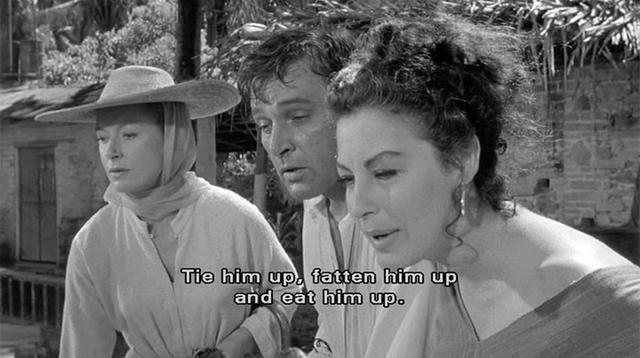
In Huston's film Nonno dies in the night after finishing his last poem, and after his funeral Hannah prepares to leave but Maxine offers her the hotel, on the condition that she run it together with Shannon. Kerr's Hannah gracefully declines the offer and walks away, back to her wandering, leaving Maxine and Shannon with each other and the hotel. Shannon might not deserve either woman, but he ends up with the one Huston concluded was temperamentally equipped to keep him together.
I can't help but imagine a third ending, where Nonno dies, his poem unfinished, and Shannon succumbs to his despair, leaving Hannah and Maxine to run the hotel together. Probably nothing like what either Williams or Huston intended, but as satisfying to a modern audience as Huston's ending and appropriate to a Netflix remake if nothing else.
Club members can let Rick know what they think by logging in and sharing in the comments below, as access to the comments section is one of many benefits that comes along with membership in the Mark Steyn Club.


